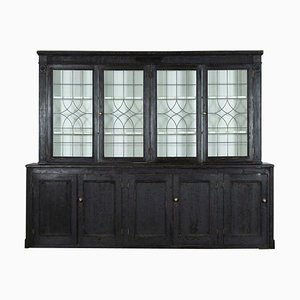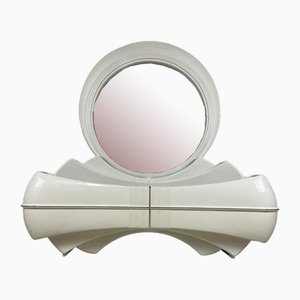Chest of drawers in violet wood, the curved front opening to five drawers in three rows, the top in red marble from Flanders resting on rounded fluted uprights, beautiful ormolu ornamentation. The PM iron remains a mystery for the time being: we can think of at least three cabinetmakers whose initials correspond to these two letters. The first, Pierre Moulin, qualified as a cabinetmaker in Paris, was living in Grande-rue-du-Faubourg-Saint-Antoine in 1710, when he married Jeanne Mainguet on November 6. He was the son of the late Pierre Moulin, painter and varnisher, and Geneviève Alexandre, who had married François Painsun, also a cabinetmaker, in a second marriage, and who had apprenticed him on July 28, 1700, to Bernard Van Risen Burgh, another great cabinetmaker of the Faubourg Saint-Antoine. The second could be Pierre III Migeon (1665-c. 1717/1719); finally, the third could be his son, Pierre IV Migeon (1696-1758), who acquired his master's degree around 1721 and went on to become one of the most important cabinetmakers in the Faubourg Saint-Antoine. It should be noted, however, that we only know the full stamp of two Migeons, hence our attribution to Pierre Moulin. Provenance: Château de Vidouze then Château de Beaulieu.
Cassettone in legno di violetta, il fronte curvo che si apre su cinque cassetti in tre file, il piano in marmo rosso di Fiandra che poggia su montanti scanalati arrotondati, bella ornamentazione in ormolu. Il ferro PM rimane per il momento un mistero: possiamo pensare ad almeno tre ebanisti le cui iniziali corrispondono a queste due lettere. Il primo, Pierre Moulin, qualificato come ebanista a Parigi, viveva a Grande-rue-du-Faubourg-Saint-Antoine nel 1710, quando sposò Jeanne Mainguet il 6 novembre. Era figlio del defunto Pierre Moulin, pittore e verniciatore, e di Geneviève Alexandre, che aveva sposato in seconde nozze François Painsun, anch'egli ebanista, e che il 28 luglio 1700 aveva fatto da apprendista a Bernard Van Risen Burgh, altro grande ebanista del Faubourg Saint-Antoine. Il secondo potrebbe essere Pierre III Migeon (1665-c. 1717/1719); infine, il terzo potrebbe essere suo figlio, Pierre IV Migeon (1696-1758), che acquisì il diploma di maestro intorno al 1721 e divenne uno dei più importanti ebanisti del Faubourg Saint-Antoine. Va notato, tuttavia, che conosciamo solo il timbro completo di due Migeon, da cui l'attribuzione a Pierre Moulin. Provenienza: Château de Vidouze poi Château de Beaulieu.




Contattaci
Fai un'offerta
Abbiamo notato che sei nuovo su Pamono!
Accetta i Termini e condizioni e l'Informativa sulla privacy
Contattaci
Fai un'offerta
Ci siamo quasi!
Per seguire la conversazione sulla piattaforma, si prega di completare la registrazione. Per procedere con la tua offerta sulla piattaforma, ti preghiamo di completare la registrazione.Successo
Grazie per la vostra richiesta, qualcuno del nostro team vi contatterà a breve.
Se sei un professionista del design, fai domanda qui per i vantaggi del Programma Commerciale di Pamono